Therapeutic protein transduction of mammalian cells and mice by nucleic acid-free lentiviral nanoparticles
- PMID: 16449199
- PMCID: PMC1356536
- DOI: 10.1093/nar/gnj014
Therapeutic protein transduction of mammalian cells and mice by nucleic acid-free lentiviral nanoparticles
Abstract
The straightforward production and dose-controlled administration of protein therapeutics remain major challenges for the biopharmaceutical manufacturing and gene therapy communities. Transgenes linked to HIV-1-derived vpr and pol-based protease cleavage (PC) sequences were co-produced as chimeric fusion proteins in a lentivirus production setting, encapsidated and processed to fusion peptide-free native protein in pseudotyped lentivirions for intracellular delivery and therapeutic action in target cells. Devoid of viral genome sequences, protein-transducing nanoparticles (PTNs) enabled transient and dose-dependent delivery of therapeutic proteins at functional quantities into a variety of mammalian cells in the absence of host chromosome modifications. PTNs delivering Manihot esculenta linamarase into rodent or human, tumor cell lines and spheroids mediated hydrolysis of the innocuous natural prodrug linamarin to cyanide and resulted in efficient cell killing. Following linamarin injection into nude mice, linamarase-transducing nanoparticles impacted solid tumor development through the bystander effect of cyanide.
Figures
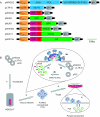
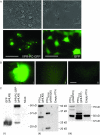
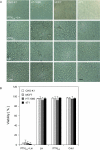
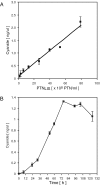
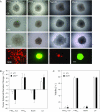

Similar articles
-
[*OPCML gene transferred by recombinant lentiviruses in vitro and its inhibition to ovarian cancer cells].Zhonghua Fu Chan Ke Za Zhi. 2006 May;41(5):333-8. Zhonghua Fu Chan Ke Za Zhi. 2006. PMID: 16762191 Chinese.
-
Anticancer effect of a lentiviral vector capable of expressing HIV-1 Vpr.Clin Cancer Res. 2001 Nov;7(11):3567-73. Clin Cancer Res. 2001. PMID: 11705878
-
Cyanide bystander effect of the linamarase/linamarin killer-suicide gene therapy system.J Gene Med. 2002 Jul-Aug;4(4):407-14. doi: 10.1002/jgm.280. J Gene Med. 2002. PMID: 12124983
-
Development of recombinant adeno-associated virus vectors carrying small interfering RNA (shHec1)-mediated depletion of kinetochore Hec1 protein in tumor cells.Gene Ther. 2007 May;14(10):814-27. doi: 10.1038/sj.gt.3302933. Epub 2007 Mar 1. Gene Ther. 2007. PMID: 17330085
-
Successful use of a plant gene in the treatment of cancer in vivo.Gene Ther. 1998 Nov;5(11):1499-507. doi: 10.1038/sj.gt.3300751. Gene Ther. 1998. PMID: 9930303
Cited by
-
Establishment and characterization of a lactating dairy goat mammary gland epithelial cell line.In Vitro Cell Dev Biol Anim. 2012 Mar;48(3):149-55. doi: 10.1007/s11626-012-9481-4. Epub 2012 Jan 20. In Vitro Cell Dev Biol Anim. 2012. PMID: 22271314
-
Protein transduction from retroviral Gag precursors.Proc Natl Acad Sci U S A. 2010 Apr 27;107(17):7805-10. doi: 10.1073/pnas.0914517107. Epub 2010 Apr 12. Proc Natl Acad Sci U S A. 2010. PMID: 20385817 Free PMC article.
-
Differential CXCR4 expression on hematopoietic progenitor cells versus stem cells directs homing and engraftment.JCI Insight. 2022 May 9;7(9):e151847. doi: 10.1172/jci.insight.151847. JCI Insight. 2022. PMID: 35531956 Free PMC article.
-
On the biomarkers and mechanisms of konzo, a distinct upper motor neuron disease associated with food (cassava) cyanogenic exposure.Food Chem Toxicol. 2011 Mar;49(3):571-8. doi: 10.1016/j.fct.2010.05.080. Epub 2010 Jun 9. Food Chem Toxicol. 2011. PMID: 20538033 Free PMC article.
-
Intracellular targeting with engineered proteins.F1000Res. 2016 Aug 10;5:F1000 Faculty Rev-1947. doi: 10.12688/f1000research.8915.1. eCollection 2016. F1000Res. 2016. PMID: 27547383 Free PMC article. Review.
References
-
- Wurm F.M. Production of recombinant protein therapeutics in cultivated mammalian cells. Nat. Biotechnol. 2004;22:1393–1398. - PubMed
-
- Cavazzana-Calvo M., Thrasher A., Mavilio F. The future of gene therapy. Nature. 2004;427:779–781. - PubMed
-
- Weber W., Rimann M., Spielmann M., Keller B., Daoud-El Baba M., Aubel D., Weber C.C., Fussenegger M. Gas-inducible transgene expression in mammalian cells and mice. Nat. Biotechnol. 2004;22:1440–1444. - PubMed
-
- Bushman F.D. Targeting survival: integration site selection by retroviruses and LTR-retrotransposons. Cell. 2003;115:135–138. - PubMed
Publication types
MeSH terms
Substances
LinkOut - more resources
Full Text Sources
Other Literature Sources
Medical

